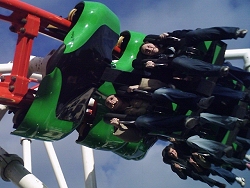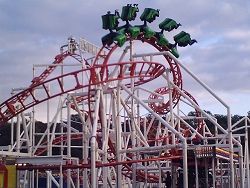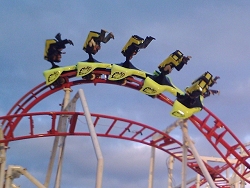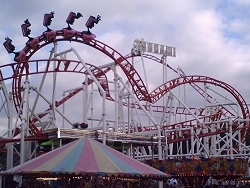I feel sorry for the people who live next door to Alan Titchmarsh. Every week, they must go out with their Flymo and trim the lawn, only to peer over the fence and see that the grass is oh-so-greener on the other side. They probably come home from the garden centre on Sunday mornings with a new pot plant, only to find Alan has outdone them again by installing some gigantic marvel of modern horticulture. Much as they must want to hate him, they have to grudgingly admit that even his poorest efforts are still light years ahead of anything they’ll ever manage themselves. I feel a special empathy for their plight, for I am part of that long-suffering group, a fairground fan who just happens to be British.
What’s so wrong with being a British fairground fan, I hear you ask. Well, it can just be so demoralising. We’ve got some excellent rides touring our green and pleasant land, and every year, I’ll visit some of Britain’s biggest fairs, and have a fine old time. Once in a while, however, I’ll go over to Germany and come back awe-struck. Much as I try to convince myself otherwise, even a medium-sized German fair is insurmountably superior to anything you’ll find in Blighty. If you have not experienced it for yourself, it is difficult to explain the size of the gulf without making you think I’m exaggerating. As much as I hate to say so, comparing German fairs with British ones is like comparing the Olympic Games to a school sports day.
 When it was announced that Scottish showmen M&D Taylor were to buy Tsunami, a Pinfari “Xpress” inverted coaster, it was undoubtedly a great moment for British fair fans. At last, we would have a decent sized coaster on the road. Sadly, two things peppered the good news. Firstly, the coaster wouldn’t actually do much travelling, as it would spend most of its time at M&D’s Theme Park in Scotland, and only appear at larger fairs, such as Nottingham or Hull (never both, as the dates are too close to allow it to be moved in time), and special events, like 2003’s Winter Wonderland at the Millennium Dome. Secondly, it was difficult to celebrate the news without feeling rather overshadowed by the fact that Germany has, for over two decades, boasted numerous coasters that were not only transportable, but world class in their own right. When you think of Dreier Looping, Thriller, Olympia Looping, Star World, Alpina Bahn, and particularly EuroStar, a Pinfari inverter suddenly seems pretty meagre in comparison.
When it was announced that Scottish showmen M&D Taylor were to buy Tsunami, a Pinfari “Xpress” inverted coaster, it was undoubtedly a great moment for British fair fans. At last, we would have a decent sized coaster on the road. Sadly, two things peppered the good news. Firstly, the coaster wouldn’t actually do much travelling, as it would spend most of its time at M&D’s Theme Park in Scotland, and only appear at larger fairs, such as Nottingham or Hull (never both, as the dates are too close to allow it to be moved in time), and special events, like 2003’s Winter Wonderland at the Millennium Dome. Secondly, it was difficult to celebrate the news without feeling rather overshadowed by the fact that Germany has, for over two decades, boasted numerous coasters that were not only transportable, but world class in their own right. When you think of Dreier Looping, Thriller, Olympia Looping, Star World, Alpina Bahn, and particularly EuroStar, a Pinfari inverter suddenly seems pretty meagre in comparison.
Still, we want to show the showmen that it is worth touring coasters to in Britain, so let’s head down to that fairground. For a relatively small ride, Tsunami has a surprisingly striking presence. At night, the whole red and white structure is subtly floodlit, while the three trains manage to burn your retinas with their day-glo liveries (bright green, bright pink, and extremely bright yellow, respectively). To the average British fair-goer, this will no doubt be an impressive sight, and arouse enough curiosity to have them opening their wallets and heading to the paybox.
With that little transaction enacted, it’s time to climb up into the loading station and take your seat. Contrary to expectations, the seats are incredibly comfy, like plonking yourself into a lovely deep orthopaedic mattress. Given that this ride is from Pinfari, the company responsible (or should that be “irresponsible”?) for such horrors as Drayton Manor’s Klondike Mine and Brighton Pier’s Turbo, the amount of padding could be taken as a warning of horrific roughness. After all, a company like Pinfari, the “Happy Shopper” of coaster builders, would hardly provide padding if it weren’t needed, would they?
 When the 10 –seater train is full (and only when it’s full – even if that takes all day), it’s time to depart the station and rumble to the lift hill. From the lift hill, you can peer down at the layout, which is very obviously “inspired” by the standard Vekoma inverted coasters (such as TraumaTizer or El Condor), commencing with a first drop that twists off to the right, before pulling into a butterfly-shaped double inversion. Where Pinfari’s design differs is that the butterfly is much more fluidly shaped than more sharply defined element, and has a sprawlingly distinctive look of its own.
When the 10 –seater train is full (and only when it’s full – even if that takes all day), it’s time to depart the station and rumble to the lift hill. From the lift hill, you can peer down at the layout, which is very obviously “inspired” by the standard Vekoma inverted coasters (such as TraumaTizer or El Condor), commencing with a first drop that twists off to the right, before pulling into a butterfly-shaped double inversion. Where Pinfari’s design differs is that the butterfly is much more fluidly shaped than more sharply defined element, and has a sprawlingly distinctive look of its own.
Once at the summit, the first drop calls, and it’s time to brace yourself for the worst. Amazingly enough, the worst never comes, and the drop works surprisingly well. Charging through the ride’s structure, the butterfly inversion beckons, and again works very well indeed. In fact, it actually works better here than on the Vekoma rides. As the train exits the second half of the inversion, the track fluidly morphs itself into a tight helix, ploughing through the forest of support structure, and leading up to the mid course brakes. So far so good. Tsunami has been smooth, reasonably intense, and great fun. Maybe we’re going to have to scrap all those suspicions we’ve ever had of Pinfari rides. Ye Gods, a good Pinfari coaster? Are there no constants left in the world?
The brakes remove a little speed, but inject a huge dose of reality into the ride. What was a fun coaster suddenly becomes a dreary, uneventful, bore. After a slow turnaround over the station roof, the train plods into the shadow of the lift hill, and creeps around to the brake run, which is itself sharp, and angled downward, as if to make a last ditch attempt to exert a little G-force, albeit in a truly unpleasant manner.
 The problem with Tsunami is that it is fairly plain to see that the designers concentrated so much on the first half of the ride that they then found they had left themselves no room in which to do anything remotely interesting with the remainder. Sure enough, what was a decent little ride becomes nothing more than an inverted monorail, making a dreary bee-line for the brakes, and rendering the ride stone dead in the process. I can’t even find myself able to say that the designers have failed in their attempts to end the ride on a high, as there is simply nothing here that even suggests that anyone tried to make it thrilling in the first place.
The problem with Tsunami is that it is fairly plain to see that the designers concentrated so much on the first half of the ride that they then found they had left themselves no room in which to do anything remotely interesting with the remainder. Sure enough, what was a decent little ride becomes nothing more than an inverted monorail, making a dreary bee-line for the brakes, and rendering the ride stone dead in the process. I can’t even find myself able to say that the designers have failed in their attempts to end the ride on a high, as there is simply nothing here that even suggests that anyone tried to make it thrilling in the first place.
So, Tsunami is a good first half followed by a lousy second half. So, does that make it a good ride or a bad one? Well, it’s basic common sense that when you’re trying to keep people entertained, the ending is by far the most important thing to get right. Regardless of how good the beginning and middle are, the finale is the one thing that will really stick in your audience’s collective mind, and form the basis of their judgement. Not convinced? Well, if you go to see a movie and are bored rigid for the first 90 minutes, then enjoy a thrilling final 30, you will leave the cinema feeling content. Likewise, you can go to a fabulous two-hour concert, but if the last song isn’t a toe-tapper, you won’t be going home with a spring in your step. Like it or not, we humans have much shorter memories than we like to think we have.
This principle applies as much to coasters as anything else. Look at any truly great coaster, and there’s always a fittingly fabulous finale to leave your heart pounding as you leave your seat and begin the post-ride discussion with your friends. Want examples? Think of the final corkscrew of Nemesis; the sublime final in-line twist of Thorpe Park’s Colossus; or EuroStar’s devastating final helix. A good ending can even redeem a ride that has a dull first half – you need look no further than the Southport Cyclone for proof.
 Tsunami’s ending, by contrast, is so feeble as to be almost embarrassing. As riders leave the train, the thoroughly respectable opening half no longer dominates the memory, but instead the commanding sentiment is one of sheer apathy. It’s certainly not likely that you’ll be scrambling for another fiver to slap on the pay desk, which is probably the biggest failing that a travelling coaster can have.
Tsunami’s ending, by contrast, is so feeble as to be almost embarrassing. As riders leave the train, the thoroughly respectable opening half no longer dominates the memory, but instead the commanding sentiment is one of sheer apathy. It’s certainly not likely that you’ll be scrambling for another fiver to slap on the pay desk, which is probably the biggest failing that a travelling coaster can have.
It wouldn’t be, if you’ll forgive the pun, fair to directly compare Tsunami with Germany’s spectacular travelling coasters, because Tsunami is designed to operate in the UK fairground culture, which is infinitely more restricted than Germany’s (of course, we could rant and rave about why the UK scene is so stifled, but that’s not a can of worms I’ll be opening here). What we can say, however, is that Tsunami should still provide a good ride. Much as I hate to say it, Pinfari has just not managed to pull it off. If I really want to say something more positive, so I will add it’s the best Pinfari coaster I have ridden, but that really is a case of damning with faint praise, given some of the God-awful rides that bear their name.
Riding Tsunami is like watching a rip-roaring murder mystery, in which the suspects are gathered for the explosive final scene, only for the detective to say he’s completely stumped, and he’s going home. As much as you want to be generous, and say that you enjoyed every second of it, you just can’t escape the feeling that something is badly missing. As a fairground fan, I’d dearly love to fly the flag for the ride, and to tell you that there’s a great coaster out there for anyone prepared to forsake the relative calm of the theme park and venture into the urban jungle of the fairground. Sadly, Tsunami is simply not that ride, and the best I can say is that I hope we can sit back in a couple of decades’ time and think “Tsunami? Ah yes, the ride that paved the way for later, greater, British travelling coasters”. Fingers crossed.
Please, do not use our ratings to compare rides head-to-head. They rate only how well this ride meets its own objectives using criteria that may not necessarily be relevant with similar reviews.

Good points:
- A bold step for a UK showman
- Much smoother than other Pinfari looping coasters
- A good first half
Bad points:
- Atrocious second half
- Can also be expensive to ride
Labels: BritishFairs, Coaster